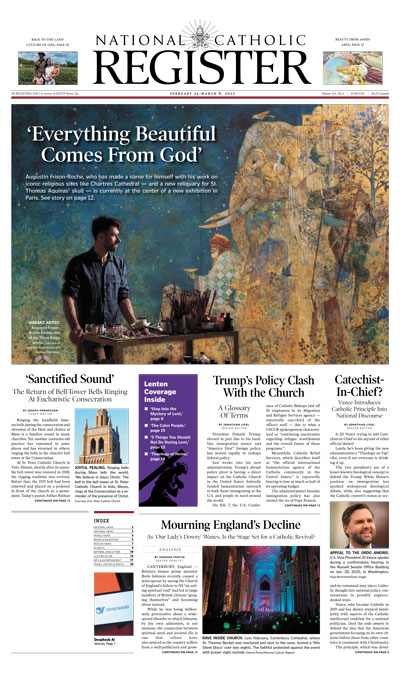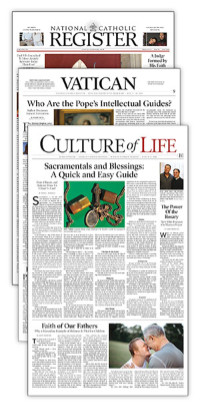What Name Will the Next Pope Choose?
Tradition, reform, or something entirely new? The new pope’s choice of name will speak volumes before he says a word.

One of the first things billions will learn about the new pope, even before he steps onto the balcony overlooking St. Peter’s Square, is the name he has chosen.
After Cardinal Dominique Mamberti proclaims “Habemus Papam!” he will announce the supreme pontiff’s Christian name, then his surname. Then finally, he’ll reveal his regnal name — the one that will follow the word “Pope.”
Most likely, nobody will have ever called him that before. And after it’s announced, most people will never call him anything else.
It’s the first message a new pope sends — even before he speaks.
“I think the choice of name is extremely important and will set the tone for the entire papacy,” Karen Park, professor of theology and religious studies at St. Norbert College in De Pere, Wisconsin, told the Register by email.
Or, as the main character in Morris West’s 1963 bestselling novel The Shoes of the Fisherman, which features a papal election, puts it: “A man’s first act sets the pattern of his later ones.”
Recent Pope Names Come With Danger
A pope can keep his own name if he chooses. Most popes during the first 1,000 years of the Church did.
But since 996, only two of the 170 popes have kept their birth names upon election: Adrian VI (1522-1523), from what is now the Netherlands, and Marcellus II (1555), from what is now east-central Italy.
In modern times, one of a new pope’s first informal acts is to explain why he chose the new name he took.
Pope Francis in 2013 cited St. Francis of Assisi, the 13th-century paragon of humility and poverty. Pope Benedict XVI in 2005 pointed to the peacemaker Pope Benedict XV (1914-1922) and St. Benedict, the sixth-century founder of Western monasticism. St. John Paul II in 1978 is widely thought to have favored Stanislaus as a papal name, after the 11th-century Polish bishop and martyr, but instead chose John Paul to honor his immediate predecessor of that name and the two popes who led the Church through the Second Vatican Council.
In the age of Wikipedia, a new pope’s regnal name will be sifted for meaning long before he even gets the chance to explain why he took it.
“When the new pope chooses his name, everyone will look for predecessors’ agendas and legacies, and whether their pontificates marked a change in the direction of the Church,” said Ralph Keen, a historian of religion and dean of the Honors College at the University of Illinois Chicago, by email.
In May 2025, if the new pope calls himself Francis II, it will signify continuity with his recently departed predecessor, who during his 12 years as pope emphasized outreach to the marginalized and de-emphasized doctrinal clarity — to the delight of some and the dismay of others.
If instead he chooses Benedict XVII or John Paul III — both names associated with popes who emphasized doctrine and presented it as a form of charity — it may seem like a repudiation of the Pope Francis era.
Any of these three names would be taken as a clear, immediate statement.
“That very fact could be a source of controversy — again, before the first statement even appears,” Keen told the Register.
Does the new pope want to be slotted as progressive or conservative — as these three popes are commonly (if often inadequately) tagged — so quickly?
Reaching Back
He has other options — but it may be easier to guess which ones he won’t choose.
Among the Church historians and observers the Register contacted this past week, few expect to hear Paul VII proclaimed from the balcony — given the struggles the most recent pope of that name (St. Paul VI) encountered during the last 10 years of his reign, when he often appeared overwhelmed.
Even less likely is Pius XIII, given the historical baggage associated with Venerable Pius XII, who is frequently — and, many argue, unfairly — criticized for not doing enough to oppose Nazism during World War II.
John XXIV — that’s “the 24th,” if the Roman numerals make your eyes glaze over — is more likely, according to some observers, because the jovial St. John XXIII (“the 23rd”) is still fondly remembered for his brief but impactful reign (1958-1963), which kicked off the Second Vatican Council.
New popes often aim to send multiple messages with a regnal name, which is part of what makes John the most popular choice among the 266 popes to date.
“The papal name John has been very important and used frequently because of the richness of the name being associated with the Gospel as well as John the Baptist and John the Evangelist, not to mention John of the Cross and other saints,” Park told the Register by email.
But if the new pope chooses to bypass Francis, Benedict, John Paul, Paul and John — names heavily used in the 20th century — he’ll have to reach back at least into the 19th century to find inspiration.
His options are thin there, too.
Don’t expect Gregory XVII (“the 17th”), for instance, because the last pope of that name, Gregory XVI (1831-1846), famously condemned “liberty of conscience” as stemming from what he called “this shameful font of indifferentism” (Mirari Vos, 14) — an unpopular idea these days. (He’s also widely remembered as having condemned railroads — though not through an official document, it seems.)
The only other possible name from the 19th century is a real contender for the next pope — Leo XIV (“the 14th”). The most recent pope of that name, Leo XIII (1878-1904), is best remembered for his 1891 encyclical Rerum Novarum — the foundation of modern Catholic social teaching — which draws praise from various wings of the Church.
Leo is also the name of one of the consensus best popes in Church history, Leo I (440-461) — better known as Leo the Great — who increased papal prestige and authority, and is widely credited with saving Rome from Attila the Hun.
If Leo proves a non-starter for the new bishop of Rome, the next most recent papal name is Clement — though it’s been a while. The most recent pope of that name, Clement XIV (“the 14th”), famously suppressed the Jesuits in 1773.
That was more than 250 years ago. But reaching far back in time for a name might be a good idea for the new pope, said Jesuit Father Thomas Worcester, a Fordham University history professor.
“I would be happy to see the new name reach back to a name that hasn’t been used in a long while,” Father Worcester told the Register, citing Leo and Clement as strong possibilities.
“I would say Leo’s the most likely if you go back more than a hundred years,” he said in a phone interview.
Reaching further into history, though, opens up complications. Names like Innocent, Alexander and Urban bring to mind popes whose records might not hold up under modern scrutiny.
Then again, the new pope might decide to correct a numerical quirk. There have been five popes named Sixtus — including the most recent, Sixtus V (1585-1590) — but no Sixtus the Sixth.
What About A Brand-New Name?
In August 1978, Blessed Pope John Paul I did something new by combining two names for his regnal name — a choice immediately echoed by his successor, John Paul II, just 51 days later.
In 2013, Pope Francis chose a name that had never been used before — the first pope to do so in more than 1,100 years, since Pope Lando in 913.
Might Francis’ successor also choose a never-before-used name?
There are plenty of options — including many that, surprisingly, have never been picked by any of the 266 popes to date.
“It’s amazing the names that have not been used,” said Dwight Duncan, a constitutional law professor at the University of Massachusetts School of Law and a canon lawyer, in a telephone interview.
He mentioned the Gospel writers Matthew and Luke as examples, as well as Lawrence — the third-century deacon martyr of Rome — who inspired an antipope of that name but not an actual pope.
“I’d like to see a name not used yet, like Joseph,” Duncan said, referring to the husband of Mary, foster father of Jesus and patron of the Universal Church.
“I think Philip would be a really good one,” he added, “because Philip Neri is the apostle of Rome during the Renaissance and Reformation,” referring to the 16th-century priest who founded the Congregation of the Oratory.
Philip is also the name of two figures in the New Testament — the Apostle Philip, who brings Nathanael to Jesus in John 1:44-46 (“Come and see”), and the deacon and evangelist Philip, who baptizes the Ethiopian eunuch in Acts 8:26-39.
Park floated Oscar, after St. Oscar Romero, the El Salvador archbishop murdered in 1980 and canonized by Pope Francis in 2018 — as well as Luke.
“Pope Luke would be a first and a call to the teachings of forgiveness and love taught by Jesus in the Gospel of Luke (Prodigal Son, Good Samaritan),” Park said by email, “and might also send a message about the centrality and dignity of women in the Church.”
Or perhaps the new pope will pick Dominic, after St. Dominic, a contemporary of St. Francis and the founder of the other 13th-century mendicant order — a possibility raised by Toby Osborne, professor of early modern European history at Durham University in England, in comments to the Register.
Osborne also noted that several Church Fathers have never been chosen as namesakes by a pope. There has never been a pope called Augustine, Jerome, Ambrose, Ignatius, Irenaeus, Cyril, Polycarp, Cyprian, Isidore, Justin, Basil, Anthony or Athanasius, for instance.
Choosing a previously unused name may help a new pope avoid being pigeonholed.
“Or they’ll pigeonhole you with a saint, rather than a clerical politician,” Duncan said.
- Keywords:
- pope
- conclave
- papal election
- church history

















